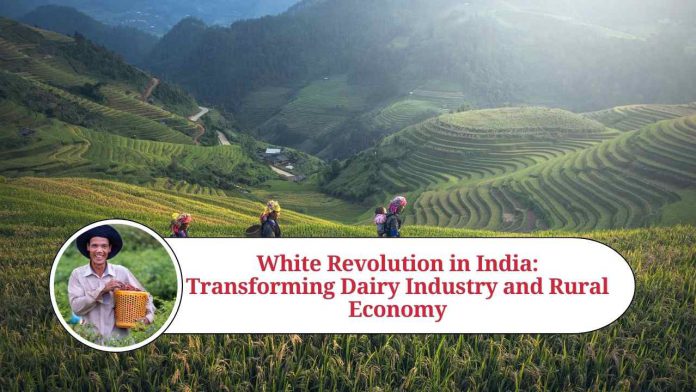India is the world’s largest milk producer, thanks to the White Revolution, also known as Operation Flood. The White Revolution is a term used to describe the transformation of India’s dairy industry, which started in 1970, and was a major success in improving the country’s economy and livelihoods of millions of rural people.
Operation Flood was initiated by Dr Verghese Kurien, a visionary and a social entrepreneur who wanted to alleviate poverty by empowering rural farmers. He recognized that the dairy sector had the potential to become a major source of income for farmers and could help transform the rural economy. Dr Kurien was instrumental in setting up the National Dairy Development Board (NDDB), which was tasked with implementing Operation Flood.
The White Revolution was based on three principles:
- Increase milk production by crossbreeding local cows with high-yielding exotic breeds such as Holstein Friesians and Jerseys.
- Build a network of milk collection centers that would provide a fair price to farmers and ensure the quality of milk.
- Establish dairy cooperatives that would be owned and run by farmers.
The first phase of Operation Flood started in 1970 and focused on increasing milk production. The government provided funds to import high-yielding exotic breeds of cows, and these were crossbred with local breeds to produce cows that were more productive. The crossbreeding program was a huge success, and milk production increased significantly.
The second phase of Operation Flood focused on building a network of milk collection centers. The NDDB worked with state governments and local communities to set up thousands of milk collection centers across the country. These centers were equipped with modern equipment to test the quality of milk and ensure that farmers received a fair price.
The third phase of Operation Flood focused on establishing dairy cooperatives. The NDDB helped farmers form cooperatives that were owned and run by them. The cooperatives were given training in management, accounting, and marketing, and they were provided with loans to set up processing plants.
The White Revolution has had a significant impact on the Indian economy and the lives of millions of rural people. Today, India is the world’s largest milk producer, and the dairy sector has become a major source of income for millions of farmers. The cooperatives have helped farmers get a fair price for their milk and have provided them with a steady source of income.
The White Revolution has also had a positive impact on the environment. The crossbreeding program has led to the development of cows that are more resistant to disease and require less food and water. This has helped reduce the environmental impact of dairy farming.
In conclusion
The White Revolution has been a major success story for India. It has transformed the dairy industry, improved the livelihoods of millions of rural people, and helped alleviate poverty. The White Revolution is an excellent example of how social entrepreneurship can help bring about positive change in society.
Read more useful content:
- Accounting Software For Manufacturing Small Businesses In India
- Offline vs Online Accounting Software Detailed Comparison
- Free Accounting Software For Small Business in India
- Most Important Advantages & Benefits of Accounting Software
Frequently Asked Questions (FAQs)
Q: What is the White Revolution in India?
A: The White Revolution is a term used to describe the transformation of India’s dairy industry, which started in 1970, and was a major success in improving the country’s economy and livelihoods of millions of rural people.
Q: Who initiated the White Revolution in India?
A: Dr Verghese Kurien, a visionary and a social entrepreneur, initiated the White Revolution in India. He recognized that the dairy sector had the potential to become a major source of income for farmers and could help transform the rural economy.
Q: What were the key principles of the White Revolution in India?
A: The White Revolution was based on three principles: Increase milk production by crossbreeding local cows with high-yielding exotic breeds such as Holstein Friesians and Jerseys, build a network of milk collection centers that would provide a fair price to farmers and ensure the quality of milk, and establish dairy cooperatives that would be owned and run by farmers.
Q: What was the impact of the White Revolution in India?
A: The White Revolution has had a significant impact on the Indian economy and the lives of millions of rural people. Today, India is the world’s largest milk producer, and the dairy sector has become a major source of income for millions of farmers. The cooperatives have helped farmers get a fair price for their milk and have provided them with a steady source of income.
Q: How did the White Revolution help the environment?
A: The crossbreeding program led to the development of cows that are more resistant to disease and require less food and water. This has helped reduce the environmental impact of dairy farming.
Q: Is the White Revolution still relevant in India today?
A: Yes, the White Revolution is still relevant in India today. The dairy sector continues to be an important source of income for millions of farmers, and the cooperatives are still playing a crucial role in ensuring that farmers get a fair price for their milk.
Q: Did the White Revolution have any international impact?
A: Yes, the White Revolution has had an international impact. The success of Operation Flood in India has inspired similar programs in other countries, such as the Livestock Development Project in Bangladesh, which was modeled on Operation Flood.




















